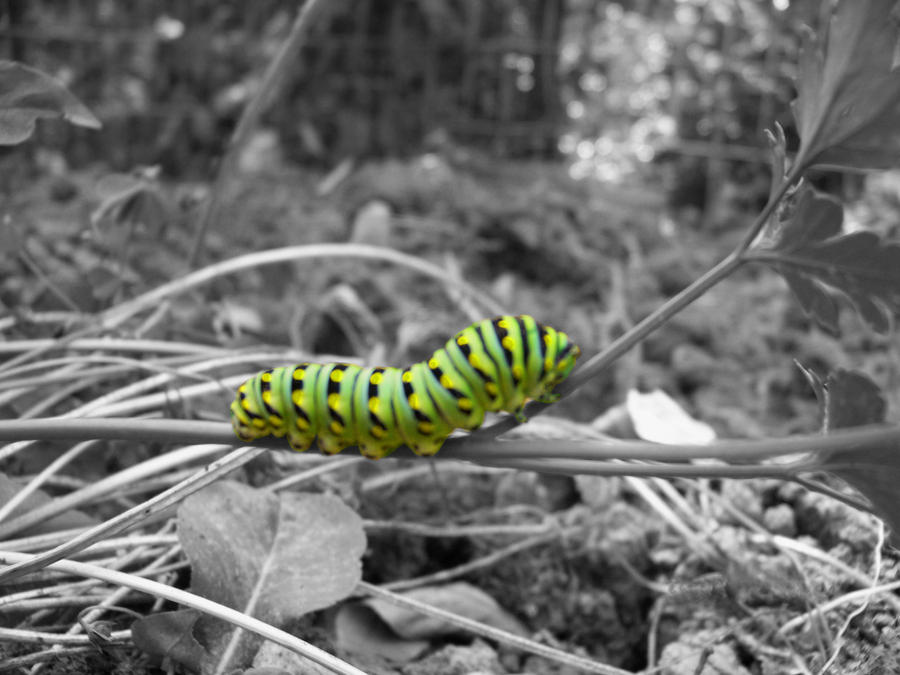 |
| 'Snowtail Catapiller' by: ~greyfortofmars |
In varies parts of the world, random small creature will stop their normal habits and start doing something rather abnormal for them.
A caterpillar will be quietly munching on a leaf, but than suddenly feel the need to climb to the tippity top of a tree, at a time of which they would usually they usually would be hiding from predators at the bottom of the tree, and dissolve.
David P. Hughes and his colleagues have found that egt, a single gene, is responsible for sending the caterpillars to the tops of trees.When this enzyme is released inside the caterpillar, it destroys a hormone that would normally tell a caterpillar to stop eating a molt.
But how does this enzyme get into the caterpillar?
Parasites. Parasites are the little beings controlling these 'zombie' caterpillars as they climb to the tops of trees and dissolve, spreading viruses like rain to the unsuspecting hosts below.
Parasites can control their host or 'zombie' in many different ways, the egt is only one example. The parasite can also control them by altering neurotransmitters in the host's brain, as thorny-headed worms do to gammarids.
Thorny-headed worms provoke a strong attack from the gammarid's immune system, however the parasite is able to fight back and the immune system, in turn, creates an inflammation that attacks its own brain.
 |
| An infected gammarid, the orange spot is the thorny-headed worm. ~source~ |
The gammarid than swims to the top of the pond, making it easy prey for a bird, which is the second and final animal a thorny-headed worm needs to live in.
Still there are more ways a parasite can 'zombify' their hosts. Texoplasma release dopamine which makes the host more curious and less fearless. When infecting male rats, Texoplasma also releases more testosterone, which makes them even more fearless.
Texoplasma has also been found to affect humans with subtle personality changes and a higher susceptibility to schizophrenia.
NOS:
The article discussed multiple scientists who are researching different types of parasites in order to better understand how they are able to control their hosts. This research is being used for a relatively new science called 'neuroparasitology.'
Their first goal is to find a new and more effective drug for various mental disorders, for which they think the answer is in parasites- particularly Texoplasma.
This article was based on evidence from the experiments run by the scientists. The scientists were curious because of the failing neuroscience departments, they wanted to find out if there was a new way to go about solving the problem of a mental disorder.
The article talked about the chance the scientists took with neuroparasitology, and they idea that they have of attacking several systems at once, as Texoplasma does, instead of attacking system with a huge attack, as a drug like Prozac does.
ARTICLE: "How to Control an Army of Zombies."
More information on Parasites and Neuroparasitology:
http://jeb.biologists.org/content/216/1/i
http://www.quantumday.com/2012/12/neuroparasitology-studies-parasites.html
http://www.livescience.com/7019-mind-control-parasites.html
Hmm... That's pretty scary. Let's hope that doesn't happen to humans!!
ReplyDeleteOn one of your related websites, there was a video describing a parasite called the liver fluke. The parasite has larvae eggs in the slime of a snail which ants come by and consume. The larvae then attaches itself onto the ant's brain and starts to control them. It basically sends the ant on a suicide mission where it latches onto flowers and mammals like cows eat the flowers along with the ant and the liver fluke. The parasite, finally, makes it to its destination in the mammal's liver where it feeds off the liver tissue. The liver fluke just like the thorny-headed worms and those parasites affecting snowtail caterpillars.
I found this article very interesting. Good work on it and I really enjoyed reading it!